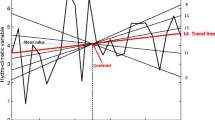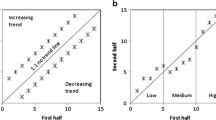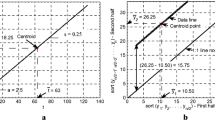Abstract
Trend identification procedures are used to identify systematic monotonic trendlines in a given hydro-meteorological time series recording to represent time-dependent variations as increases or decreases. Different methodologies have been proposed for such descriptions, but most of them require restrictive assumptions such as normal (Gaussian) probability distribution function (PDF), serial independence, and long sample sizes. In particular, pre-whitening and over-whitening are recommended to meet the need for serial independence, but they cannot transform a serially dependent series into a completely independent one. In this paper, a new trend methodology is proposed based on the characteristics of crossings along any given straight line within the given time series, and the sought-after trend component is the one with the maximum number of crossings. This approach does not require any restrictive assumptions. Unlike previous trend algorithms, the proposed cross-empirical trend analysis (CETA) does not give a single trend, but a series of trends at different levels within the variation range of hydro-meteorological time series records. For the sake of brevity, only three levels are considered in this article, at 10%, 50%, and 90% risk levels. The comparison of the CETA approach is presented with the classical and frequently used Mann–Kendall (MK) trend determination procedure method based on Sen’s slope calculation. For very small series correlation coefficients and normal PDF function cases, CETA and the classical technique give almost the same trendline within the ± 5% error band. The application of this methodology is presented for monthly and annual discharge records of the Danube River and annual precipitation records from seven geographical regions of Turkey.















Similar content being viewed by others
Data availability
The data are obtained from internet for Danube River and for Turkish rainfall records from the General Directorate of Meteorology, Turkey.
Code availability
The code is written in Matlab by the authors and it is available on request.
References
Ahmadi F, Nazeri Tahroudi M, Mirabbasi R, Khalili K, Jhajharia D (2018) Spatiotemporal trend and abrupt change analysis of temperature in Iran. Meteorol Appl 25(2):3124–3321. https://doi.org/10.1002/met.1694
Bayazit M, Önöz B (2007) To pre-whiten or not to pre-whiten in trend analysis? Hydrol Sci J 5(4):611–624. https://doi.org/10.1623/hysj.52.4.611
Chakravarty IM et al (1967) Handbook of methods of applied statistics. Willey Publications, New York
Hamed KH, Rao AR (1998) A modified Mann-Kendall trend test for autocorrelated data. J Hydrol 204(1):182–196. https://doi.org/10.1016/S0022-1694(97)00125-X
Hirsch RM, Alexander RB, Smith RA (1991) Selection of methods for the detection and estimation of trends in water quality. Water Resour Res 27(5):803–813. https://doi.org/10.1029/91WR00259
Khalili K, Tahoudi MN, Mirabbasi R, Ahmadi F (2016) Investigation of spatial and temporal variability of precipitation in Iran over the last half century. Stoch Env Res Risk Assess 30(4):1205–1221. https://doi.org/10.1007/s00477-015-1095-4
Kendall MG (1975) Rank correlation methods, 4th edn. London, Charles Griffin
Mann HB (1945) Non-parametric test against trend. Econometrica 13:245–259
Milly PCD, Betancourt J, Falkenmark M, Hirsch RM, Kundzewicz ZW, Lettenmaier DP, Stouffer RJ (2008) Stationarity is dead: whither water management? Science 319:573–574
Sen PK (1968) Estimates of the regression coefficient based on Kendall’s Tau. J Am Stat Assoc 63:1379–1389
Spearman C (1904) The proof and measurement of association between two things. Amer J Psychol 15:72–101. https://doi.org/10.2307/1412159
Şen Z (2012) Innovative trend analysis methodology. J Hydrol Eng 17(9):1042–1046
Şen Z (2017) Hydrological trend analysis with innovative and over-whitening procedures. Hydrol Sci J 62(2):294–305. https://doi.org/10.1080/02626667.2016.1222533
Şen Z (2018) Crossing trend analysis methodology and application for Turkish rainfall records. Theor Appl Climatol 131:285–293. https://doi.org/10.1007/s00704-016-1980-x
Yue S, Pilon P, Cavadias G (2002) Power of the Mann-Kendall and Spearman’s rho tests for detecting monotonic trends in hydrological series. J Hydrol 259(1):254–271. https://doi.org/10.1016/S0022-1694(01)00594-7
Author information
Authors and Affiliations
Contributions
Only the author contributed to this article.
Corresponding author
Ethics declarations
Ethics approval
This article abides by copyright laws.
Consent to participate
Not applicable.
Consent for publication
Not applicable.
Conflict of interest
The authors declare no competing interests.
Additional information
Publisher's note
Springer Nature remains neutral with regard to jurisdictional claims in published maps and institutional affiliations.
Rights and permissions
About this article
Cite this article
Şen, Z. Crossing empirical trend analysis (CETA) at risk levels in hydro-meteorological time series. Theor Appl Climatol 148, 145–163 (2022). https://doi.org/10.1007/s00704-022-03946-4
Received:
Accepted:
Published:
Issue Date:
DOI: https://doi.org/10.1007/s00704-022-03946-4




